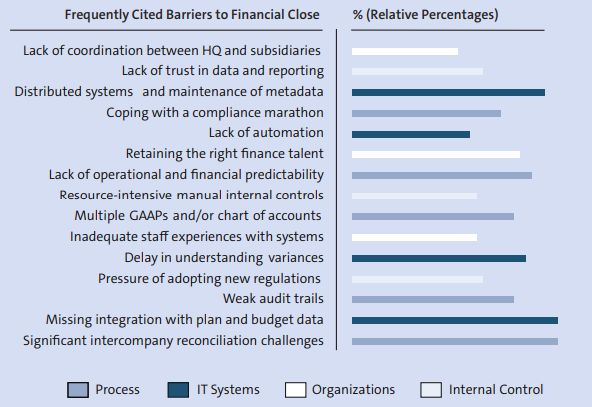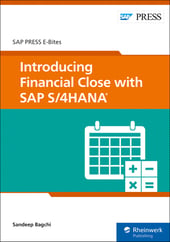The faster the finance team can close the books and deliver real-time insights to key stakeholders, the more strategic value the finance and accounting department can bring to the business.
An informed finance executive knows that a well-planned, well-designed, technology-enabled financial close is a critical best practice by which the office of the CFO is measured. A streamlined close process with reproducible results benefits organizations by reducing variability and hence improving agility and transparency in the close process. The ultimate goal of a strong business case is to help the finance function drive progress and provide a clear baseline for measuring results during the close process and, as a result, give the stakeholders a greater comfort of understanding the data.
Current Financial Close Challenges
A look at today’s industry leading practices suggests that a world-class close can be defined as a three-day close for legal entities, plus two days for consolidation and reporting, totaling five days.
Yet today, only 38% of companies appear to close their books in five to six days. Although some close their books in the system within a week, they attribute two weeks after the technical (system) close to reconcile their data and provide their leadership with the variance analysis from plan to actual. The remaining 62% of companies attribute a slower close to growing business complexity and increased regulatory requirements.
Even after spending millions of dollars implementing the best enterprise resource planning (ERP) applications, the close process continues to be fragile and massively complex for many organizations. One possible explanation is that some organizations’ close processes are still run by institutional memory rather than via clear and specific protocols. Organizations justify this historical method with the notion that different people involved in the process “just know how things get done,” implying that implementing a method would be a complex change. The figure below shows how having complex processes, inadequate infrastructure, and disparate systems with a lack of internal controls leads to choking up the close process.

Drivers for an Improved Financial Close
Improvement to the financial close process extends beyond an organization’s closing checklists, to closing cycle time, accuracy, and compliance while optimizing costs. The business case for a streamlined financial close process is driven by the following four critical factors.
External and Internal Stakeholders
Different stakeholders in the organization have different expectations for the close process. The external stakeholders are entities who care about and are affected by its performance (e.g., consumers, regulators, investors, suppliers). They expect higher-quality information made available faster and more efficiently. On the other hand, internal stakeholders are entities within a business (e.g., employees, managers, the board of directors). They expect greater insight, with more real-time and on-demand data for the financial results so that timely critical business decisions can be made with accurate analysis.
Regulatory Drivers
Section 409 of Sarbanes-Oxley (SOX) requires that public companies report any material event that results in a change of the company’s financial condition within four days of the event. The rules regarding the 10-Q and 10-K filing deadlines as part of an amendment of the SEC Act of 1934 has led to a six-day deadline to file form 10-K and a 40-day deadline to file form 10-Q. These regulatory requirements have pushed the office of the CFO towards a faster closing and reporting.
Work-Life Balance
Finance and accounting teams are famous for working long hours during the close process. A better work-life balance achieved through a streamlined close process allows the close activities to be spread across the month and is an important driver of improved employee satisfaction. Researchers have concluded that work-life balance is an important factor to attract and retain high-quality professionals.
Faster Access to Critical Business Matrices
Companies need accurate, reliable, and timely information to grow within this fast-paced, competitive business environment. The need for faster access to critical financial metrics related to the performance of their business is one of the critical drivers for an efficient and effective close process today.
Decision Considerations
Before we decide to improve the financial close process and create a business case and roadmap for its implementation, I strongly recommend looking at the following criteria for the future close process in your organization:
Close Type
This can be broadly categorized into two types based on an organization’s business requirements: the soft close and the hard close.
Soft close is best described as the process of closing the books without dealing with the host of complex accruals, manual allocations and reposting, contingencies, and reserve accounting entries. It produces financial data to help enable the finance team to see a snapshot of the financial state of the company using trial balances and management reporting key performance indicators (KPIs).
In the hard close, all the transactions for the period are processed and there is no more financial activity allowed for that period. This closing type focuses on the accuracy and auditability of the results, which are used for internal management decision-making and external reporting. It is very resource-intensive and requires almost a week to generate the numbers for the financial statements and another week to consolidate and publish the results.
The question that organization needs to decide is whether the hard close is necessary every month end. Can the business leverage the soft close processes on a monthly basis in preparation for the hard close at the quarter end?
Changing Perspective: New-Old Approach
It had been a norm for accounting teams to operate like assembly lines. Each team member has specific responsibilities during the close cycle which, when executed correctly, results in the final product—financial results—only at the end of the line. The challenge with this process is that by the time the finance team finishes the close process, the financial statement is old news and therefore of minimal value to decision-makers. There is very little time left to analyze results from the previous month close before the priorities turn to closing the books for the current month.
In order to move away from this assembly line approach, companies are switching over to a new perspective called the continuous close or continuous accounting. The new process deals with closing the books through the month and not wait for the month end. It enables these organizations to perform a “soft close” at any time because the business teams are constantly processing and compiling the relevant financial information throughout the month. They may still decide to perform a “hard close” at the end of each month or quarter, but the continuous accounting throughout the month drastically decreases the time to close.
There is no doubt that continuous accounting represents a paradigm shift for the finance departments that, in the past, has had to rely on the antiquated assembly line batch processes. Is your organization ready for this paradigm shift?
Organization: Centralized Versus Decentralized Close
We all know that in centralized organizations, primary decisions are concentrated within a particular geographical location group and are distributed down the chain of command. In comparison, decentralized organizations delegate decision-making authority throughout the organization. The question that all businesses need to ask before embarking on improving the financial close process is whether or not it matters whether your close process is centralized or decentralized, or run locally, regionally, or from another continent. Should the process be organized in such a way as to be responsive to the business needs and be able to respond to business changes, new risks, system issues, disaster contingency, and other scenarios that could impede progress?
Conclusion
Whatever stage of the journey you’re at right now in your close process, it is critical to understand how a streamlined and transparent financial close enables you to efficiently deliver an accurate and complete representation of a company’s financial performance to key stakeholders on a timely basis. Finance teams within each organization can effectively navigate away from the “perfect storm” that resulted from fragmented and unstructured close activities by optimizing their processes and implementing appropriate ERP technology.
To better understand how finance users can reduce the time spent supporting the close process in SAP S/4HANA and reprioritize other value-adding activities within their organizations, read my E-Bite from SAP PRESS, Introducing Financial Close with SAP S/4HANA. Also, learn how Accenture can help you stand up to resilient finance capabilities with SAP solutions.
Learn more about SAP S/4HANA Finance here and how SAP S/4HANA can help with financial close.
This post was originally published 12/2020.




Comments